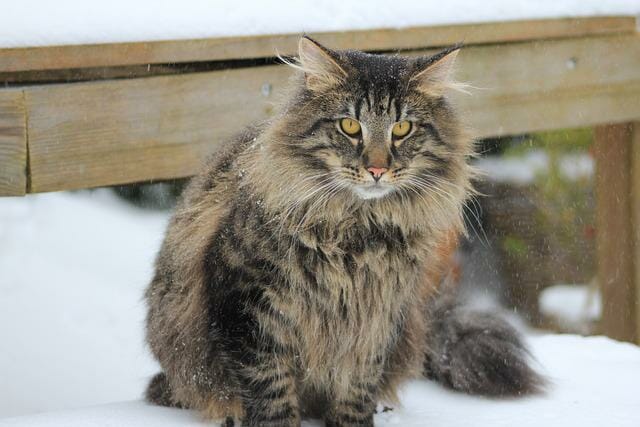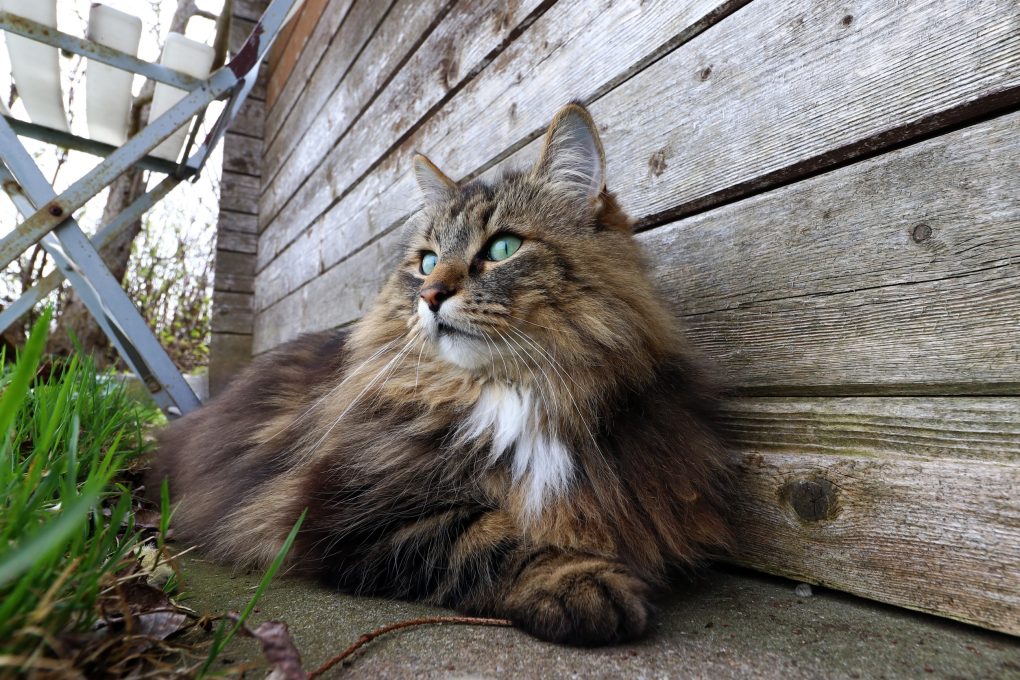Are Norwegian Forest Cats Good Pets: The Pros and Cons of Having Norweigan Forest Cats as Pets
Yes, Norwegian Forest cats can make great pets for the right owner. They have friendly and outgoing personalities, as well as an affectionate nature. They are also intelligent and enjoy interactive play, making them good companions for those who enjoy spending time with their pets.
However, it’s important to note that Norwegian Forest cats are active and require regular exercise and mental stimulation to prevent boredom and destructive behavior. They also have a thick, long coat that requires frequent grooming to prevent matting and tangles.


Table of Contents
The Pros of Having Norwegian Forest Cats as Pets
Affectionate Companionship
When a cat is affectionate, it means they enjoy being close to their owners, and they show this by seeking out physical contact, such as cuddling, nuzzling, and purring. The affectionate nature of Norwegian Forest cats can bring several benefits to their owners.
For one, it can help create a strong bond between the cat and its owner. The cat will feel more comfortable and secure in the home, which can reduce stress levels for both the cat and the owner.
Affectionate cats also provide great comfort and companionship to their owners. They are often eager to sit on laps, curl up in bed with their owners, or be nearby when relaxing or working. This can help reduce feelings of loneliness or isolation, which can be especially important for people living alone or going through a difficult time.
In addition to providing emotional support, affectionate cats can be entertaining. For example, they may engage in playful behavior, such as chasing toys or pouncing on their owners, which can bring great joy and laughter to the household.
Many people are torn between Norwegian Forest Cat and Maine coon cat, for both are exceptional choices for a pet. However, the Norwegian Forest Cat is known for its affectionate and playful nature, making it an excellent family companion.
Intelligent and Playful
Norweigan Forest cats can learn new things and solve problems, which can be entertaining and rewarding for their owners. When a cat is playful, it means that they are energetic and enjoy engaging in interactive play, which can be fun for its owners.
The intelligence of Norwegian Forest cats can manifest in several ways. First, they are quick learners and can easily pick up on new routines and habits. They may also be able to learn simple tricks, such as jumping through hoops or responding to certain commands. This can provide a fun and rewarding activity for the cat and its owner.
The playful nature of Norwegian Forest cats can also benefit their owners. They are often eager to engage in interactive play, including chasing toys, beating strings, or playing hide-and-seek. This can provide a great deal of entertainment for both the cat and its owner and help provide exercise and mental stimulation for the cat.
The playful nature of Norwegian Forest cats can also help strengthen the bond between the cat and its owner. Playing with the cat can create positive associations and memories, which can help the cat feel more comfortable and secure in the home. It can also be fun to spend time together and create happy memories.
In case you are wondering who is more playful other than the Norwegian Forest cat, Ragdoll and Norwegian Forest Cats are generally considered to be intelligent and playful breeds.
Good With Children and Other Pets


Norwegian Forest cats are gentle, social, and loving animals. They have a playful nature and are often described as good with children and other pets, making them great for families.
One of the reasons why Norwegian Forest cats are good with children is because they have a patient and calm temperament. They are not easily frightened and are generally very tolerant of children’s playful antics. They are also affectionate towards their owners, often seeking attention and cuddles.
Additionally, Norwegian Forest cats are highly intelligent and adaptable animals. They are capable of learning tricks and can be trained to follow commands. This makes them great companions for children, as they can provide them with hours of entertainment while also helping them to develop valuable skills such as responsibility and empathy.
Regarding other pets, Norwegian Forest cats are typically very friendly and accommodating. They are social creatures and enjoy interacting with others, whether it’s a fellow feline or a different species altogether. They are generally not aggressive towards other animals and can coexist peacefully.
However, it’s important to note that socialization is key when introducing a Norwegian Forest cat to other pets. Therefore, it’s essential to introduce them to other animals slowly and carefully, as this will help to prevent any potential conflicts.
The Cons of Having Norwegian Forest Cats as Pets
High Energy
While Norwegian Forest cats are gentle and affectionate, they are also a breed that is known to have high energy levels. This can be a con for some people, as it requires a lot of exercise and stimulation to keep them happy and healthy. One of the main challenges of owning a high-energy cat is that it can become bored easily if not given enough mental and physical stimulation.
This can lead to destructive behavior, such as scratching furniture, chewing on cords, or knocking things over. In addition, cats that are not given enough exercise can become overweight and develop health problems such as diabetes or joint issues.
To prevent these issues, it’s important to provide your Norwegian Forest cat with plenty of opportunities for exercise and play. This can include providing them with toys, scratching posts, and climbing structures to keep them entertained. In addition, regular play sessions and interactive games such as fetch or laser tag can also help to keep them physically and mentally stimulated.
It’s also worth noting that Norwegian Forest cats are an active breed that enjoys exploring their environment. As such, there may be better choices for people who live in small apartments or homes with access to outdoor space. They thrive in larger homes or rural areas where they can run and play to their heart’s content.
Requires Regular Grooming
While the long and fluffy fur is one of the Norweigan Forest cat’s most striking features, it also requires much upkeep. They have a double-layered coat with a soft undercoat and a longer, coarser topcoat. This type of coat helps to protect them from the cold weather, but it also means that their fur can become easily tangled and matted if not properly groomed.
To keep their coat in good condition, Norwegian Forest cats like Turkish Angora must be brushed at least once or twice a week and more frequently during shedding season. Brushing helps to remove any loose fur and prevent matting, which can be painful for the cat and difficult to remove.
In addition to regular brushing, Norwegian Forest cats may also need occasional baths to help keep their coat clean and free from mats. However, it’s important to use cat-specific shampoo and to avoid getting water in their ears or eyes during the bath.
Another grooming task that may be required for Norwegian Forest cats is nail trimming. Like all cats, they need to have their nails trimmed regularly to prevent them from becoming too long and causing discomfort or even injury to the cat.
While regular grooming can be time-consuming, it’s essential to caring for a Norwegian Forest cat. Neglecting their grooming needs can lead to various health issues, including skin irritation, infections, and behavioral problems.
Strong Prey Drive


As a breed originally used for hunting rodents and other small prey, Norwegian Forest cats can be skilled at stalking and catching small animals. While this may not be a problem for some owners, it can concern those with other pets or small children.
Various stimuli, such as the movement of small animals, birds, or insects, can trigger the prey drive of a Norwegian Forest cat. This can make keeping them away from other pets challenging, especially if those pets are smaller than the cat.
In addition, Norwegian Forest cats can also be quite territorial and may become aggressive toward other cats or animals they perceive as a threat. This can be particularly problematic if the cat is introduced to a new pet or animal.
Providing plenty of mental and physical stimulation is important to manage a Norwegian Forest cat’s prey drive. This can include interactive toys, scratching posts, and play sessions that simulate hunting and stalking behaviors. Supervising the cat around other animals or small children is also important to ensure they do not become aggressive or predatory.
In some cases, it may be necessary to keep the Norwegian Forest cat separated from other pets in the household, particularly if there are concerns about their safety. This can be done by providing the cat with a separate living space, such as a designated room or area in the house.
